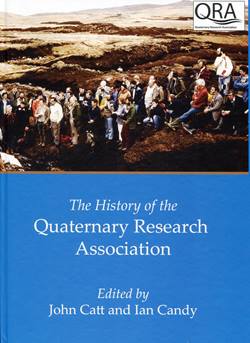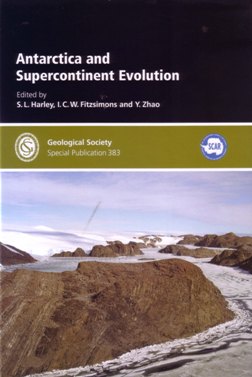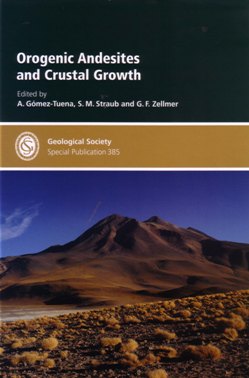
History of the Quaternary Research Association
It is 50 years since the Quaternary Field Study Group held its first meeting based on the Department of Geology at the University of Birmingham. After four years, this Study Group became more formalised as the interdisciplinary Quaternary Research Association (QRA), and in the late 1980s it became one of the specialist groups of the Geological Society.
Courageously, the Executive Committee resolved to self-publish a history to mark the anniversary. It is in two parts – first, a conventional history and second, a selected set of 12 chapters commissioned by the committee on topics considered to reflect the more important topics allied to QRA members’ work. The book is a handsome A4 hardback with 108 mainly coloured figures and 39 tables. It is of considerable weight, and pleasingly printed in Wales.
The history is the sole work of founder member John Catt, who, with prodigious energy, has scoured the archives and the pages of the in-house published Quaternary Newsletter to reconstruct, often in considerable detail, the trials and tribulations of the Association through half a century. Interestingly, of the c. 150 original members some 50 survive, although the membership now exceeds 1000. One suspects that this part will give the greatest enjoyment to those survivors. There is an index to this part, but it is not totally comprehensive.
Part II is jointly edited by Catt and Ian Candy and covers ‘The scientific achievements and contributions of the QRA’. It features 10 key topics written by a mix of sole and joint authored chapters –in journal format and not indexed. One gets the impression that the contributors - 16 in all - were given lax word limits as there is a wide range of page length, 13–50 pages and stricter editorial control might have shortened the longer ones and, by consolidating the references into a single list, space would have been created for additional topics such as climatic modelling/ prediction, radioactive and stable isotopes, palaeosols and periglaciation. Nevertheless the chapters are delightful reading as the authors trace progress in understanding in their respective fields.
The QRA is to be congratulated on producing this landmark volume at a price which is simply exceptional value. By adopting a ‘mutual’ publishing model one hopes that the sales of this excellent people-centred book will not be restricted by a lack of publicity – spread the word!
Reviewed by Peter Worsley
- THE HISTORY OF THE QUATERNARY RESEARCH ASSOCIATION by JOHN CATT & IAN CANDY (eds). Published by: Quaternary Research Association, 2014 ISBN : 0907780873. 431pp List price : £25.00, Order from www.qra.org.uk at £31 including postage and packing.

Antarctica and Supercontinent Evolution
Antarctica’s geological record spans 3.5 billion years and provides a remarkable window into the geological history of the world. This book has a summary chapter followed by eight detailed chapters providing an insight into current understanding of the evolution of Antarctica, and where Antarctica may have been incorporated into supercontinents of old. The discussion ranges across Antarctica, California, Africa, India and Australia.
The introductory chapter summarises the current state of knowledge of the ancient supercontinents and how the geology of Antarctica has contributed to this. The chapter concludes with a summary of the uncertainties that remain. This is mind-boggling stuff. The remaining eight papers present evidence covering geochemistry, mineralogy and tectonics and are summarised briefly below.
Chapter 2 documents the lithotectonic zones present in Rayner Province and how these are similar to features in the Albany-Fraser Orogen in Western Australia. Chapter 3 describes how feldspar-lead isotopic information from Eastern Antarctica can be correlated with mineral compositions from Dharwar Craton and the Eastern Ghats. A different mineralogy is also described in the Ruker Complex in Antarctica suggesting a different post-Archaean evolution.
Chapter 4 sets out the tectonic implications drawn by examining the mineralogy in the Larsemann Hills, Prydz Bay in East Antarctica. Chapter 5 describes the complex tectonothermal events evident in rocks making up the Prince Charles Mountains of the Prydz Bay region, East Antarctica.
Chapter 6 describes the metamorphic rocks in the central Sor Rondane Mountains, eastern Dronning Maud Land, East Antarctica, and proposes the area be a test-ground for the regional tectonic processes proposed for the orogeny of Gondwana.
Chapter 7 presents information on the mineralogy of garnet-sillimanite gneisses in Eastern Antarctica and the implications of the P-T path matches on ultrahigh-temperature metamorphosis.
Chapter 8 moves to West Antarctica and discusses the differences in isotopic composition of zircons in granite found in the area. Chapter 9 provides additional insight into how the composition of detrital zircon in northern Victoria Land, Antarctica is evidence of a range of rock forming mechanisms ranging from contemporaneous magmatic activity to erosion of older crustal sources currently covered by the polar ice sheet.
Reviewed by James Montgomery
- ANTARCTICA AND SUPERCONTINENT EVOLUTION by S L HARLEY, I C W FITZSIMONS AND Y ZHAO (eds). Published by: Geological Society, Special Publication 383, 2013. ISBN 978-1-86239-367-7, 237pp hbk. Bookshop

Early Palaeozoic Biogeography and Palaeogeography
Palaeobiogeographers can rejoice; here is a detailed and comprehensive memoir setting out the state of art of your ‘craft’. This memoir originates mostly from the work of two International Geoscience Programmes; The Great Ordovician Biodiversification Event (IGCP 410, 1997 -2002) and ‘Ordovician Palaeogeography and Palaeoclimate’ (IGCP 503, 2004 – 2009). It draws together a lot of specialist detail and presents the results of multidisciplinary collaboration between scientists at the leading edge of their game.
There are 26 Chapters by over 140 authors, in a densely written format covering dominantly the Cambrian and Ordovician, with some excursions into the Silurian - up to Pridoli where warranted. These cover; Trace Fossils, Stromatoporoidea, Porifera, Corals, Brachiopods, Bryozoa, Echinoderms (superb photography) , Gastropods, Bivalves, Molluscs, Polychaetes, Trilobites, Ostracods, Phyto and Zooplankton, Radiolaria, Graptolites, Cephalopods, Vertebrates and Land Plants.
The central concept is that through the extensive use of similar maps, such as ‘Bugplates,’ (see www.geodynamics.no/bugs/SoftwareManual.pdf) as a basis for comparison and assessment; the origin, evolution and radiative distribution of life forms can be elucidated and hypothesised upon. Thus a good platform has been established onto which further detail can be built. Read in combination with the considerably more accessible Atlas of Palaeogeography and Lithofacies1 this should form a defining framework.
While most of the book will be of immediate interest to working and aspiring palaeontologists, especially those with good palaeobiolexidexterous tendencies. For the rest of us, the best advice is to read the first three chapters, and then dip into the rest slowly.
At this point I would make a plea: for the non-specialist, some of the terminology used and concepts described create an entry barrier, inevitable in a specialist memoir. However it might be fairly easily rectified with ‘barrier-busting’ companion notes placed online. (There is already a significant amount of supplementary material there). Publications of this type are intended as a communication between experts, but it would be a shame to keep the developing story of the Earth’s radiative evolution a ‘secret’ among so few friends.
Reviewed by Arthur Tingley
Reference
- Cope J C W, Ingham, J K & Rawson, P F (eds.) 1992. Atlas of Palaeogeography and Lithofacies. Geological Society, London, Memoir, 13.
- EARLY PALAEOZOIC BIOGEOGRAPHY AND PALAEOGEOGRAPHY, by HARPER D A T AND SERVAIS T (eds) 2013 Published by: Geological Society. London, Memoir 38. List price: £125.00; Fellow's price: £62.50 Other societies price: £75.00. W: Bookshop

Orogenic Andesites and Crustal Growth
The significance of orogenic andesites (the voluminous andesites formed at convergent plate margins and volcanic arcs) as petrogenetic proxies for the evolution of continental crust has been recognised and established for over three decades. However, their genesis remains highly contentious and is still much debated. The controversy as to whether orogenic andesites are the products of primary melts of mantle and crustal slab materials, or are derived from basaltic mantle melt differentiation in overlying crust within convergent margin environments, remains uncertain and problematic. This Geological Society Special Publication documents the recent research developments undertaken to address this fundamental petrogenetic issue.
Introduced with an overview chapter on the current state of research on orogenic andesites, the volume is broadly divided into three main sections, presenting recent research papers investigating the crustal slab – mantle connection (four papers on the influence of slab fluids, melts and diapirs, their associated melt-rock reactions and melt transfer timescales), and the role of the overriding crust in these systems (eight papers examining crustal melt and magma evolution and their residence times). The final section synthesises the recent research investigating the temporal evolution of orogenic andesites and their contribution to continental crustal growth and development (three papers).
In summary, the volume thoroughly demonstrates that the debate on the origin of andesitic melts at convergent margins (i.e. formation from primary melts of slab or mantle materials versus evolution from basaltic melts at shallower crustal levels) is an active, significant and unresolved research area in igneous petrogenesis. The volume is non-dogmatic and well-balanced on this important issue favouring neither particular genetic viewpoint. Attempting to establish a forum for discussion, the volume successfully promotes the need for new and further research efforts on the petrogenesis of these important and enigmatic rocks and their role in the global geochemical cycles of the Earth.
The editors are to be congratulated on an excellent and significant contribution to the field. This reviewer anticipates that the editors’ stated purpose for the volume to facilitate cross-fertilisation and discussion between researchers proposing these opposite (and potentially irreconcilable) genetic hypotheses and enable the establishment of a mutually holistic model for orogenic andesite petrogenesis, will ultimately be realised.
Reviewed by Mark Griffin
- OROGENIC ANDESITES AND CRUSTAL GROWTH by A GOMEZ-TUENA, S M STRAUB AND G F ZELLMER (eds). Published by: Geological Society of London. Special Publication No 385, 2014. ISBN 978-1-86239-369-1. Hbk. 414pp. ISSN 0305-8719. List Price: £125.00. W: www.geolsoc.org.uk.